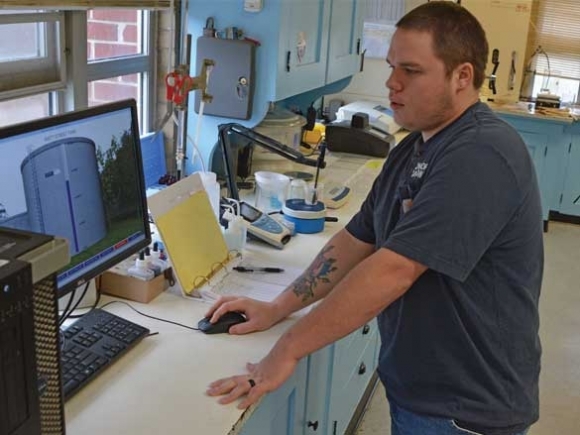Haywood water systems join forces to aid each other in times of need

From the control room of Canton’s water plant, a steady barrage of numbers flash across the computer monitors.
Chlorine readings, upstream river monitors, pumping volume, intake gauges — but the one workers track the most transmits real-time water levels from four storage tanks that stand like sentinels on the hillsides around town.
After water is sucked from the Pigeon River and treated, it’s pumped and piped to the four tanks, and from there flows out to Canton’s water customers. The tank levels rise during the night, drain out quickly during the morning shower rush, and the chore of refilling them starts over.
SEE ALSO:
• In the wake of the drought, Haywood towns besieged by water shortage search for answers
During the prolonged drought this fall, however, water levels in the Pigeon River fell dangerously low, taxing the water plant’s ability to keep up with the constant uphill slog to fill the tanks.
As daily briefings from the water plant grew more dire, Canton Town Manager Seth Hendler-Voss called for an emergency meeting of all the county’s water players.
Related Items
The result was the formation of a countywide water task force aimed at cracking the water conundrum, hopefully finding new ways to move water supplies between Waynesville, Canton and Maggie Valley in times of need.
While it’s not apparent above ground, all five water systems in Haywood County are daisy-chained together. The valves between systems are usually closed, but in an emergency, the hatch can be opened to let water flow between them.
But some connections dating to the 1980s were poorly engineered and don’t work well, and some only work in one direction — posing a hurdle to get water from Waynesville’s well-endowed reservoir to Canton on the other end of the county.
“We are in a very fortunate position here in Waynesville, but even if in our largess we wanted to help them could we do it?” Waynesville Mayor Gavin Brown posed.
The biggest water daddy in the county is no doubt Waynesville. Waynesville pulls its water from a dammed-up lake, providing a robust cushion in times of drought.
Despite the comparatively deep pockets of Waynesville’s 8,000-acre watershed, could it be stretched enough to give everyone what they needed?
“Would Waynesville be able to continue to provide water to their own customers if everyone else is relying on them?” Hendler-Voss said.
That’s the million-dollar question, and Waynesville wants it answered as much as anyone.
“I would love to get this done when it is raining and there is no political pressure on us,” Waynesville Town Manager Rob Hites said. “What we were scared about is the entire county showing up in the town board room and telling us they have to have water and they are really hurting and we are in the position of saying ‘We can’t give you all the water you are asking for.’ That’s a terrible position.”
While the drought threat has passed, the water players are committed to the work they started and hope to find solutions to future water emergencies — ranging from back-up water sources to better interconnections linking neighboring water systems.
“The idea is to have an operative plan in good times so if and when the drought comes again, we are all over it,” sais Josh Nickol, manager of Junaluska Sanitary District. “That’s the premise of where we are going with this group. It is for the betterment of all of Haywood County.”
During a meeting of the water task force in December — it’s second one since forming in November — the county’s water players realized just how many unknowns and outliers they’re dealing with.
One of the biggest mysteries: an old water line between Canton and Clyde that’s never been used and was largely forgotten about. Presumably, it was part of an interconnection plan three decades ago that failed to launch.
Hendler-Voss hoped the line could be resurrected. If so, Junaluska Sanitary District and Clyde could act as middlemen to wheel water from Waynesville to Canton during emergencies.
“Will the interconnect currently get water up over Radio Hill?’” Hendler-Voss posed.
Sadly, they learned the answer was no.
“Apparently, they never designed or built the booster pump that would push water through,” Hites said. “It was meant to be a true interconnect, but it just didn’t work. It’s what’s called a dry line.”
That spells bad news for Canton.
“Canton is the one kind of out in the wilderness right now,” said Waynesville Alderman LeRoy Roberson after Hites briefed his board on the task force’s work to date.
Common denominator
While the drought brought water players to the table, it’s not the only crisis where connected systems would help. If a fire raged through Evergreen Packaging in Canton, the town’s water storage tanks — holding close to 4 million gallons — could be drained from a wide-open affront.
“If we had a major fire at the mill and were being sucked dry we would need a lot of water right away,” Hendler-Voss said.
“I think the entire county would suffer if we had a serious fire at the mill. Every water company has to team up to help them in the case of a serious fire,” Brown added.
While Waynesville sits in the catbird seat when it comes to water supplies, it could find the shoe on the other foot one day, needing an interconnect just as much as the other towns.
“If you put 10 or so fire trucks around a catastrophic fire you can drain a million gallon tank in an hour,” Hites said. “We could drain our tanks and our water plant couldn’t treat it fast enough to put it back in the system. It can happen to any of us — big towns and small towns. That’s the reason for an interconnected water system.”
By joining forces, water systems in Haywood County are hoping to land a state planning grant to identify solutions for the missing links.
“We want to partner as a coalition to attract grant money for an interconnect study and ultimately the projects that would provide water to all municipalities during drought events and emergency infrastructure failure,” Hendler-Voss said.
Joy Garland, Clyde’s town administrator, said the undertaking shows the cooperative spirit between neighboring communities.
“We all came to the table and talked about ‘OK what can we do to help us not be in this situation again? What kind of improvements could we look at for our systems so we would have some alternatives,” she said. “I don’t think that anybody that has been at the table in these conversations would not help their neighbor.”
In the past, some towns in Haywood have been prone to turf battles. But that doesn’t seem to be the case now, or when dealing with the critical need of water.
“I think we have a level of cooperation between the municipalities we may not have had. We work really well together,” Hendler-Voss said.
Gauging the water
The first order of business for the water task force is an assessment of existing water supplies. Pegging a hard and fast number isn’t easy, however.
There’s often a disconnect between the volume a water plant can handle, and what the water source puts out.
In Canton, the water plant can treat up to 4 million gallons a day, and under normal river flows, the Pigeon has that much to give.
But the real capacity is limited due to a flawed intake design.
“We have never brought that much in and never will with the design of pumps we have now,” said Mark Jones, Canton’s water plant manager.
Due to the intake hurdles, the plant can’t process more than 2 million gallons a day instead of the 4 million it’s technically capable of.
Of course, it’s all hypothetical and dependent on river flows.
“This isn’t an issue of plant capacity as much as water availability,” Hendler-Voss said.
Maggie Valley Sanitary District went through a round of drought response planning of its own less than a decade ago, following a major drought in 2007.
“When we went through that process we realized we didn’t have a great plan B,” said Neil Carpenter, manager of the Maggie water utility.
To provide a back-up, Maggie and Waynesville built a new interconnection between their systems. Waynesville was prepared to turn it on in the drought but to date it’s only been used once, following a massive storm a few years ago.
“It actually washed so much debris on our intakes that it covered them up and for a 24-hour period we used that interconnect,” Carpenter said.
On paper, Maggie and Waynesville’s water systems have been linked since the 1980s.
“But to be honest it wasn’t functional,” Carpenter said.
Lacking pumps, water couldn’t actually move between the systems.
Therein lies another challenge for the task force: to analyze the existing landscape of pipes, pumps and tanks, and ultimately determine where the gaps are.
“We need a hydraulic model of all the water systems in the county to see how we can wheel large amounts of water from place to place,” Hites said.
Catbird seat
Water hasn’t yet proven lucrative for Waynesville, despite selling 450,000 gallons of bulk water a day to Junaluska Sanitary District and Lake Junaluska Assembly. The neighboring water systems buy water from Waynesville at a wholesale rate and resell it to their own customers at a mark-up.
The bulk sales brought in $550,000 last year, according to calculations by Waynesville Finance Officer Eddie Caldwell.
There’s not a lot of profit off the sales. The town was able to net a surplus of $114,00 off its water system last year to fund town projects, but most of the money it makes on wholesale water contracts goes back into the water system itself.
To Hites, the question isn’t how much Waynesville could make from selling water, but how much it can spare.
“I think one of the biggest calculations that Waynesville will have to do is determine based on our projected growth how much water we should retain for our own customers and how much we should sell,” Hites said.
Junaluska Sanitary District is moving Waynesville’s water out N.C. 209 to communities north of I-40, and as far as Clyde.
“When you are looking at selling water to a water system that is serving growth 10 miles away along I-40, when Waynesville has a growth spurt we have no surplus for our own needs,” Hites said. “We don’t have more than that reservoir. That’s all we’ve got. That’s the balancing act. We want to help the county grow and be good stewards, but any businessman would say he wouldn’t sell all his inventory.”
Part of the planning process would be devising an emergency contract to govern the wholesale transfer of water from one system to another. How much would Waynesville charge, and what kind of cut would Junaluska Sanitary be entitled to for wheeling the water over its lines to Clyde and Canton?
“That is all stuff we would have to work out. We are the middle guy and are an important piece of this,” Nickol said of Junaluska Sanitary. “But if and when we ever supply Clyde, it will be for an emergency situation and not to make money.”
Nonetheless, Junaluska Sanitary is making sizeable infrastructure investments on a larger trunk line along Hospital Drive — replacing an 8-inch and 6-inch line with a new16-inch line — and it would be nice to recoup some of that investment if its new line is pressed into service as an interconnection.
Not a new idea
A couple of years ago, Junaluska Sanitary District pitched the idea of an interconnection with Clyde, but it failed to rally support from the necessary water players. Canton and Waynesville — the two water suppliers whose water Junaluska Sanitary would be wheeling back and forth if the interconnect came to fruition — were skeptical of the motive. Some postulated that Junaluska Sanitary was pursuing the interconnection in a strategic move to position itself as the middleman in control of the water wheelhouse.
Adding to the confusion, an old interconnection between Clyde and Junaluska Sanitary already existed, but had apparently been forgotten about in Junaluska Sanitary District’s pursuit of a new interconnection.
The institutional knowledge of the old interconnection dating to the 1980s had been largely been lost.
Garland said she for one was well aware of the old interconnection, but Clyde wasn’t looped in to the discussion or she would have volunteered the information.
“We were not aware or approached about them trying to get the interconnect,” Garland said.
Garland said the interconnection with Clyde has only been used three times to her knowledge.
“The last time was in 2005 or 2006, when Canton had the scare of the mysterious barrels in the river. They notified us and we turned off our connection with them and turned on the emergency interconnect with Junaluska,” Garland recalled.
For two or three days, the people of Clyde drank water all the way from Waynesville’s reservoir, being wheeled across the pipes of Junaluska Sanitary to reach Clyde’s doorstep.
That was 10 years ago, however. After re-discovering its existence in 2015, Clyde and Junaluska wondered if it would still work. So they tested it out last spring — first unlocking a metal trap door to an underground concrete vault, then climbing inside and manually cranking a wheel to open the valves between Junaluska Sanitary and Clyde. It fired right up.
Garland attempted to piece together the who, what, when and why of the old interconnection.
“I think the ultimate goal was to have a countywide interconnect,” Garland said. “That’s the same goal we are working on right now. We have to have a solid back-up plan.”
Indeed, the idea on the table today isn’t a new one, Hendler-Voss agreed.
“This is not a new proposition but the drought has given each municipality pause and really brought this need back to full life,” Hendler-Voss said. “We’re focused on what’s the approach we need now to make this project a reality.”
What’s different this time is that the water players in the county are pursuing the interconnection jointly, with everyone in the driver’s seat together.
“That’s why we decided to get together now as a coalition and make sure we are all doing if for the right reasons and get off on the right foot,” Hendler-Voss said. “It is not about making money or selling water for cheaper rates. We are doing this for the sake of emergencies and that’s it.”









